Related Research Articles

A castle is a type of fortified structure built during the Middle Ages predominantly by the nobility or royalty and by military orders. Scholars usually consider a castle to be the private fortified residence of a lord or noble. This is distinct from a mansion, palace and villa, whose main purpose was exclusively for pleasance and are not primarily fortresses but may be fortified. Use of the term has varied over time and, sometimes, has also been applied to structures such as hill forts and 19th- and 20th-century homes built to resemble castles. Over the Middle Ages, when genuine castles were built, they took on a great many forms with many different features, although some, such as curtain walls, arrowslits, and portcullises, were commonplace.
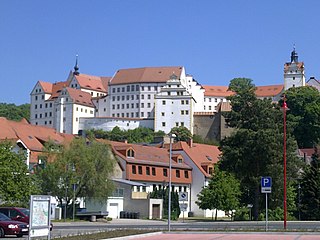
Colditz is a small town in the district of Leipzig, in Saxony, Germany. It is best known for Colditz Castle, the site of the Oflag IV-C POW camp for officers in World War II.

A doll is a model typically of a human or humanoid character, often used as a toy for children. Dolls have also been used in traditional religious rituals throughout the world. Traditional dolls made of materials such as clay and wood are found in the Americas, Asia, Africa and Europe. The earliest documented dolls go back to the ancient civilizations of Egypt, Greece, and Rome. They have been made as crude, rudimentary playthings as well as elaborate art. Modern doll manufacturing has its roots in Germany, from the 15th century. With industrialization and new materials such as porcelain and plastic, dolls were increasingly mass-produced. During the 20th century, dolls became increasingly popular as collectibles.
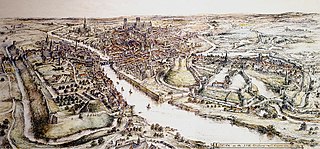
A motte-and-bailey castle is a European fortification with a wooden or stone keep situated on a raised area of ground called a motte, accompanied by a walled courtyard, or bailey, surrounded by a protective ditch and palisade. Relatively easy to build with unskilled labour, but still militarily formidable, these castles were built across northern Europe from the 10th century onwards, spreading from Normandy and Anjou in France, into the Holy Roman Empire, as well as the Low Countries it controlled, in the 11th century, when these castles were popularized in the area that became the Netherlands. The Normans introduced the design into England and Wales. Motte-and-bailey castles were adopted in Scotland, Ireland, and Denmark in the 12th and 13th centuries. By the end of the 13th century, the design was largely superseded by alternative forms of fortification, but the earthworks remain a prominent feature in many countries.

A toy train is a toy that represents a train. It is distinguished from a model train by an emphasis on low cost and durability, rather than scale modeling. A toy train can be as simple as a toy that can run on a track, or it might be operated by electricity, clockwork or live steam. It is typically constructed from wood, plastic or metal. Many of today's steam trains might be considered as real ones as well, providing they are not strictly scale or not enough detailed ones in favor of a robustness appropriate for children or an inexpensive production.
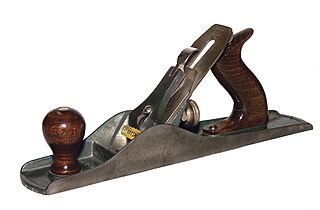
A hand plane is a tool for shaping wood using muscle power to force the cutting blade over the wood surface. Some rotary power planers are motorized power tools used for the same types of larger tasks, but are unsuitable for fine-scale planing, where a miniature hand plane is used.

A toy soldier is a miniature figurine that represents a soldier. The term applies to depictions of uniformed military personnel from all eras, and includes knights, cowboys, American Indians, pirates, samurai, and other subjects that involve combat-related themes. Toy soldiers vary from simple playthings to highly realistic and detailed models. The latter are of more recent development and are sometimes called model figures to distinguish them from traditional toy soldiers. Larger scale toys such as dolls and action figures may come in military uniforms, but they are not generally considered toy soldiers.

A dollhouse or doll's house is a toy house made in miniature. Since the early 20th century dollhouses have primarily been the domain of children, but their collection and crafting is also a hobby for many adults. English-speakers in North America commonly use the term dollhouse, but in the United Kingdom and other English-speaking countries the term is doll's house. They are often built to put dolls in.
Brio is a wooden toy company founded in Sweden. The company was founded in the small town of Boalt, Scania, Götaland in 1884 by basket maker Ivar Bengtsson. For a long time the company was based in Osby, Scania, in southern Sweden. In 1908 Ivar's three sons took the company over and gave it the name "BRIO", which is an acronym for: BRöderna Ivarsson (in) Osby. In 2006 BRIO moved its headquarters to Malmö, Scania. It is best known for its wooden toy trains, sold in Europe since 1958.

A keep is a type of fortified tower built within castles during the Middle Ages by European nobility. Scholars have debated the scope of the word keep, but usually consider it to refer to large towers in castles that were fortified residences, used as a refuge of last resort should the rest of the castle fall to an adversary. The first keeps were made of timber and formed a key part of the motte-and-bailey castles that emerged in Normandy and Anjou during the 10th century; the design spread to England, and south to Italy and Sicily. As a result of the Norman invasion of 1066, use spread into Wales during the second half of the 11th century and into Ireland in the 1170s. The Anglo-Normans and French rulers began to build stone keeps during the 10th and 11th centuries; these included Norman keeps, with a square or rectangular design, and circular shell keeps. Stone keeps carried considerable political as well as military importance and could take up to a decade or more to build.
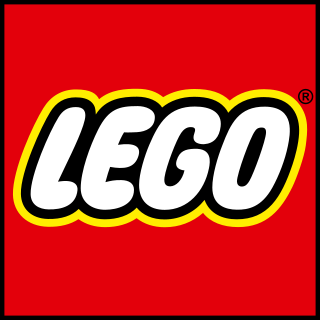
This article lists notable events and releases in the history of the Lego Group.
The history of Lego began in 1932, when Ole Kirk Christiansen who owned a Danish carpentry workshop that at first only produced furniture started making wooden toys and later named the new toy company Lego in 1934. Later when injection molding was introduced to Denmark after World War II Ole Kirk bought an injection molding machine for the company to make toys in 1947. That same year Kirk and his son obtained samples of plastic, interlocking bricks which inspired the later lego bricks created in 1949. The brick and lego system continued to be modified with new molds and colors being added and removed over the decades. Lego still continues into the 21st century as a popular and very profitable line of construction kits and related products and services, with a significant impact on various areas in popular culture. Despite its expansion, the company remains privately held.
1:144 scale is a scale used for some scale models such as micro/mini armor. 1:144 means that the dimensions of the model are 1/144 (0.00694) the dimensions of the original life-sized object; this equates to a scale of 1/2 inch per 6 feet of original dimension. For instance, an airplane 30 feet (9.14 m) in length would be a mere 2.5 inches (63.5 mm) long as a 1:144 scale model.
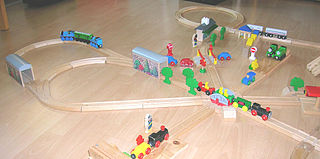
Wooden toy trains are toy trains that run on a wooden track system with grooves to guide the wheels of the rolling stock. While the trains, tracks and scenery accessories are made mainly of wood, the engines and cars connect to each other using metal hooks or small magnets, and some use plastic wheels mounted on metal axles. Some trains are made to resemble anthropomorphical, fictional, and prototypical railroad equipment.

Liubice, also known by the German name Alt-Lübeck, was a medieval West Slavic settlement near the site of modern Lübeck, Germany. Liubice was located at the confluence of the Schwartau with the Trave across from Teerhof Island, approximately four kilometres north of Lübeck's island old town. The residence of Henry, the Christian prince of the Obotrites, Liubice was destroyed after his death by the pagan Rani of Rugia.
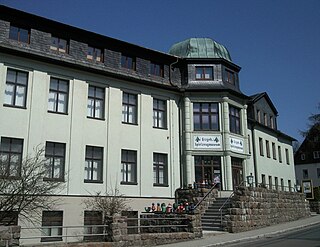
Ore Mountain folk art is a well-known form of highly artistic wood carving from East Germany. It encompasses the diverse forms of expression of the creative work beyond the classical or the modern arts, and in particular the production of figures, sculptures and paintings. In a broader sense, the people's poetry, literature, and the Ore Mountain songs are in itself the folk art. The Ore Mountains claim to be the largest, enclosed folk art area in Germany.

Mettoy was a British manufacturing company founded in 1933 by German émigré Philip Ullmann, who was later joined by South African-born German Arthur Katz who had previously worked for Ullmann at his toy company Tipp and Co of Nuremberg. The firm made a variety of lithographed metal wind-up toys. Both Jewish, they moved to Britain following Hitler's rise to power in 1933.
David Allen Hickling, known as Allen Hickling, was an Architect, Planning/Strategic Choice Process consultant, author, game designer, and an authority in the field of toy forts and castles.
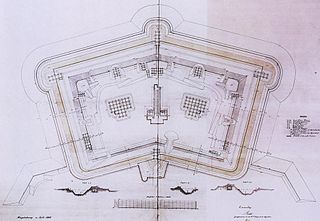
A polygonal fort is a type of fortification originating in France in the late 18th century and fully developed in Germany in the first half of the 19th century. Unlike earlier forts, polygonal forts had no bastions, which had proved to be vulnerable. As part of ring fortresses, polygonal forts were generally arranged in a ring around the place they were intended to protect, so that each fort could support its neighbours. The concept of the polygonal fort proved to be adaptable to improvements in the artillery which might be used against them, and they continued to be built and rebuilt well into the 20th century.
Nuremberg kitchen is the traditional English name for a specific type of dollhouse, similar to a room box, usually limited to a single room depicting a kitchen. The name references the city of Nuremberg, the center of the nineteenth-century German toy industry. In German the toy is known as a Puppenküche.
References
- ↑ Köhler, Swantje. "All About Old Toys - Christian Hacker". Old Wood Toys.
- ↑ diePuppenstubensammlerin (2014). "Moritz Gottschalk - a brief history". Doll's Houses Past & Present.
- ↑ Ackerman, Evelyn (1994). The Genius of Moritz Gottschalk. Gold Horse Publishing. ISBN 978-0912823454.